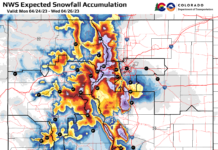by Faith Engel

West Grand middle schoolers learned about
water and water issues last week. (Pictured)
Sixth graders walk along the trail in the canyon.
The students at West Grand Middle School visited the Pumphouse at CO River CR1 (Trough Rd,) and the Wolford Dam on September 12-14, as part of “Watershed Week,” which was sponsored by a grant from the Summit Foundation.
Katherine Morris- a Grand Co. water specialist, presented to the kids at the Gore Canyon Whitewater Play feature about the water rights purchased by Grand County, including the basics of why these water rights are important to their community and how we share water rights with communities on the front range. The older kids sampled micro-invertebrates and measured water quality and stream velocity.
Kayli Foulk and Mary Price from GCWIN took the kids on a guided hike into the canyon to discuss and define watersheds with activities planned to lead discussions about the quality of water and how watersheds can be a source of fresh water, but also funnel pollutants. The kids enjoyed spraying food dye representing several types of contaminants and watching them roll down a plastic tarp shaped like a watershed before hiking back for the second part of their morning.
Ken Belcher, John Marcelle, and Grey Pickett from the Bureau of Land Management, held a lecture on the recent Mountain Pine Beetle epidemic. Topics for discussion included the role of insects and disease on the forest environment, impacts on the hydraulic cycle and water quality, (as well as on the Lodgepole Pine forests themselves,) and the benefits of forest management on maintaining healthy forests. The presentation from the BLM ended with a demonstration measuring an actual tree so that they could understand how a tree is measured without climbing it, but by using math equations instead.
The 6th graders also visited Wolford Dam, where students put themselves in the shoes of the 2 billion citizens worldwide who still fetch and carry their water, taking part in a race to fill buckets manually. A discussion followed about how we take advantage, and perhaps even waste this valuable resource because of the convenience of plumbing. Students were informed about the dam using terms they were now familiar with for measuring volume, and contemplated the need for awareness and conservation of this natural resource in Kremmling.










